Why rebrand or rename your company?
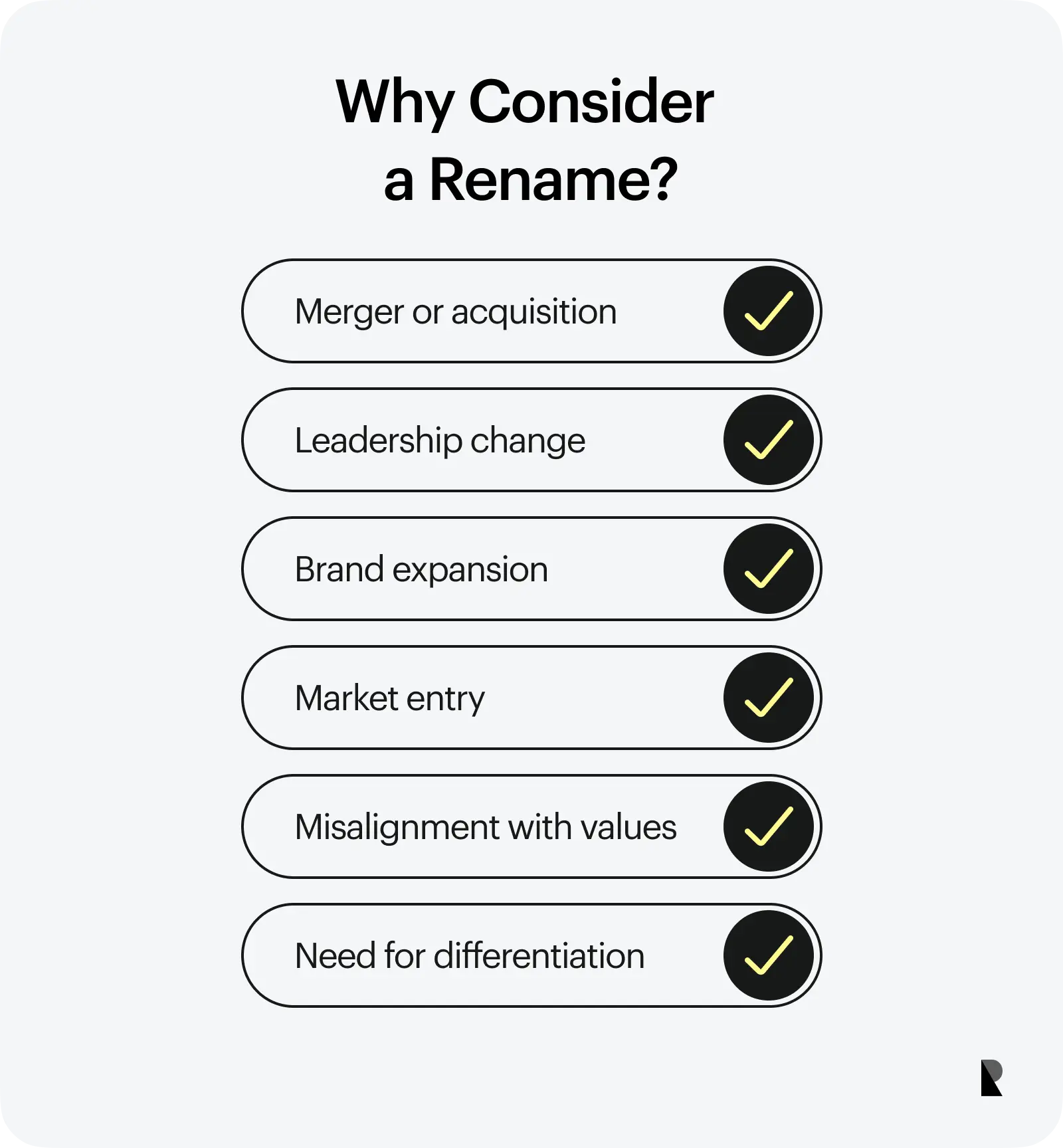
A brand name is one of the first things a new business needs to establish before launching. However, the names or visual identity may sometimes miss the mark. Situations along the way may warrant a business name change or even a total rebrand.
However, doing so is not as easy as announcing a new name to the public. Here's everything you need to know for a successful name change or rebranding.
Rebranding or renaming your business happens more often than you think. Here are the top reasons why a name change or rebranding is beneficial.
Acquired or merged with another brand
Mergers and acquisitions happen when companies join forces to expand their market shares, reduce operational costs, and attain other benefits.
When two companies with different teams and visual identities come together, customers can be confused about who to trust. Therefore, rebranding or a name change makes sense at this stage. It signals a new beginning, encourages collaboration within the organization, and opens doors to a stronger market position.
Change in leadership
New organization leaders may need to start fresh by introducing new visions and goals. They may also have new strategies that target different market needs. A rebrand is then necessary to reflect these changes effectively. The current brand suffers from a poor reputation.
Reputational damage can arise from varying factors that businesses may fail to address. This includes poor customer service, online backlash from negative articles or reviews, unethical treatment of employees, data breaches, and other scandals.
A rebrand can signal that your company is ready to acknowledge arising issues and proactively make changes to serve its customers better.
Growing your brand line
Growth is inevitable for brands that excel at creating products the market needs. As these brands expand, they realize that a single brand cannot hold all their products.
Take Meta, formerly known as Facebook. The tech giant announced the name change in 2021 to reflect its bigger goal of creating a metaverse beyond Facebook.
In its press release, the company shares, "When Facebook launched in 2004, it changed how people connect…Now, Meta is moving beyond 2D screens toward immersive experiences like augmented and virtual reality to help build the next evolution in social technology."

Facebook is now Meta. Image via Meta
Exploring a new market
As brands evolve, some brand names can be limiting.
America's well-loved donut brand, Dunkin' Donuts, has changed gears by dropping half its name. Now, it is known as Dunkin'.
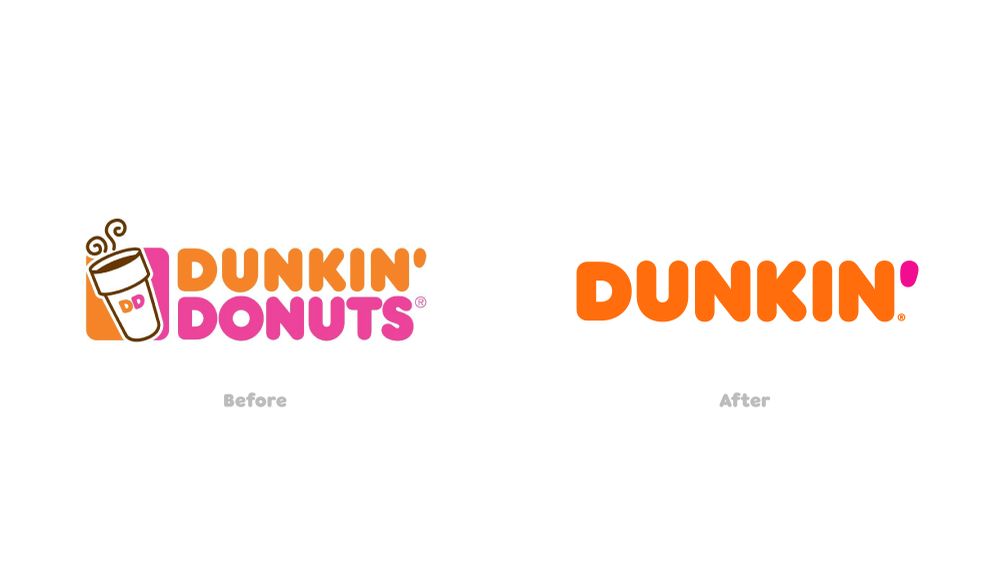
Dunkin’ drops ‘donuts’ as it continues to offer products in other categories. Image via Dunkin Donuts News
But why the name change?
Years go by, and the donut company has expanded its product offerings. This has obsolete the brand name, as Dunkin' Donuts sells donuts and a wide range of beverages. Renaming it, Dunkin' was also a strategic move to adapt to changing times. It sounds modern, all-encompassing, simple, and easy to remember.
Brand misaligned with values
Part of adapting to evolving market conditions is changing company goals and values. For instance, many customers today value sustainability and are more willing to support brands that align with them. Goals and values change when a company undergoes restructuring, too. It adapts beliefs that will improve collaboration within the company and foster innovation.
A name change or a rebrand is an appropriate step to reflect these.
You want to differentiate your brand
Did you know that Unilever's petroleum jelly brand Vaseline is called Vasenol in Portugal, Brazil, and other Spanish-speaking countries?
Vaseline has become a generic term for petroleum jelly products in these places. As a solution, Vaseline has been renamed Vasenol.

Vaseline changes its name to Vasenol in Brazil and Portugal. Image via Vasenol
A similar case happened with Dove Chocolate in the UK. Because of the popularity of Unilever's personal care brand, Dove, in the country, Dove Chocolate needed to change its name to Galaxy to avoid confusion.

Dove Chocolate rebrands to Galaxy to avoid confusion with the personal brand, Dove. Image via Behance
How to rename your brand in five steps
Step 1: Conduct a brand audit
A brand audit is a historical account of all the branding assets, marketing campaigns, visual identity, sales data, customer feedback, and target demographics to pinpoint a brand's strengths and weaknesses.
It uncovers gaps and inconsistencies of the existing brand that the new brand name may fill and improve. Finally, it reveals your audience's and investors' current perception of your brand.
A brand audit involves using tools such as SWOT analysis, visual identity tools, customer surveys, data analytics, and focus group studies.
Step 2: Define the brand’s mission, vision, and values
Identifying your brand mission, vision, and values helps orient your company as you create a new identity. The brand mission addresses why a business exists, vision refers to the company's long-term goals beyond profit making, and values are the beliefs and principles a company stands for.
Step 3: Brainstorm and generate new names
Now that you know your brand's position in the market and have developed its core values, mission, and vision, it's time to consider new brand names.
The brainstorming process is a collaborative phase that requires involving the right people. The more ideas from different perspectives, the better your chances of developing something that aligns with your new branding.
Get your stakeholders, marketing team, and creative team on board. You can also use some ideas from sales representatives who have first-hand knowledge of your customers since they are in direct contact with them. Or you can ask for help from a reliable branding agency.
Step 4: Check trademark and domain availability
In Australia, Burger King is called Hungry Jack's. But why the name change?
When businessman Jack Cowin decided to open Burger King franchises in the 1970s, a chain of local restaurants with a similar name already existed. To avoid confusion, Cowin and Burger King Corporation renamed their brand to Hungry Jack's.
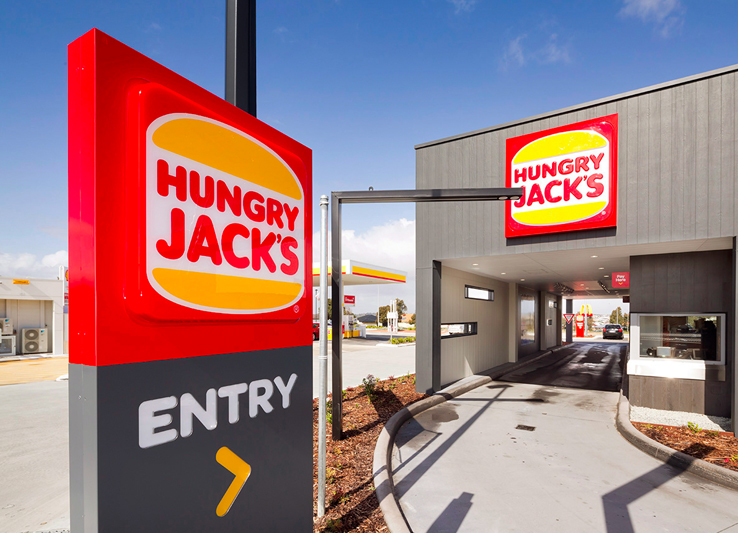
Burger King is called Hungry Jack’s in Australia. Image via Hungry Jack’s
Fortunately, there are tons of online resources from the government that you can use to conduct a trademark search and avoid legal and regulatory dilemmas. In the US, businesses can search for federally registered trademarks using USPTO's Trademark Electronic Search System (TESS).
Other tools include LegalZoom Trademark Search, WIPO Global Brand Database, and Trademark Engine. You can also avail of trademark monitoring services to detect potential infringements and conflicts in your trademarks should other businesses use your brand name.
Businesses can search for domains on GoDaddy, Wix, and Namecheap, among others. These platforms also have features that can assist you in finding the right domain to match your brand identity.
Step 5: Test the new brand name with the target audience
Your new brand name needs to be memorable, relevant, and appealing.
You can conduct test runs and ask your audience for feedback to ensure your brand name is cohesive and resonates with your brand. For instance, conduct a survey or a focused group discussion. Implement A/B testing and present different brand names to your audience segments. This will help you identify their preferences.
You can also create mock-ups of logos, packaging, and advertisements to see how your brand name visually fits. Lastly, reach out to your internal team. They can give you invaluable insights as they better understand the brand's vision than your audience.
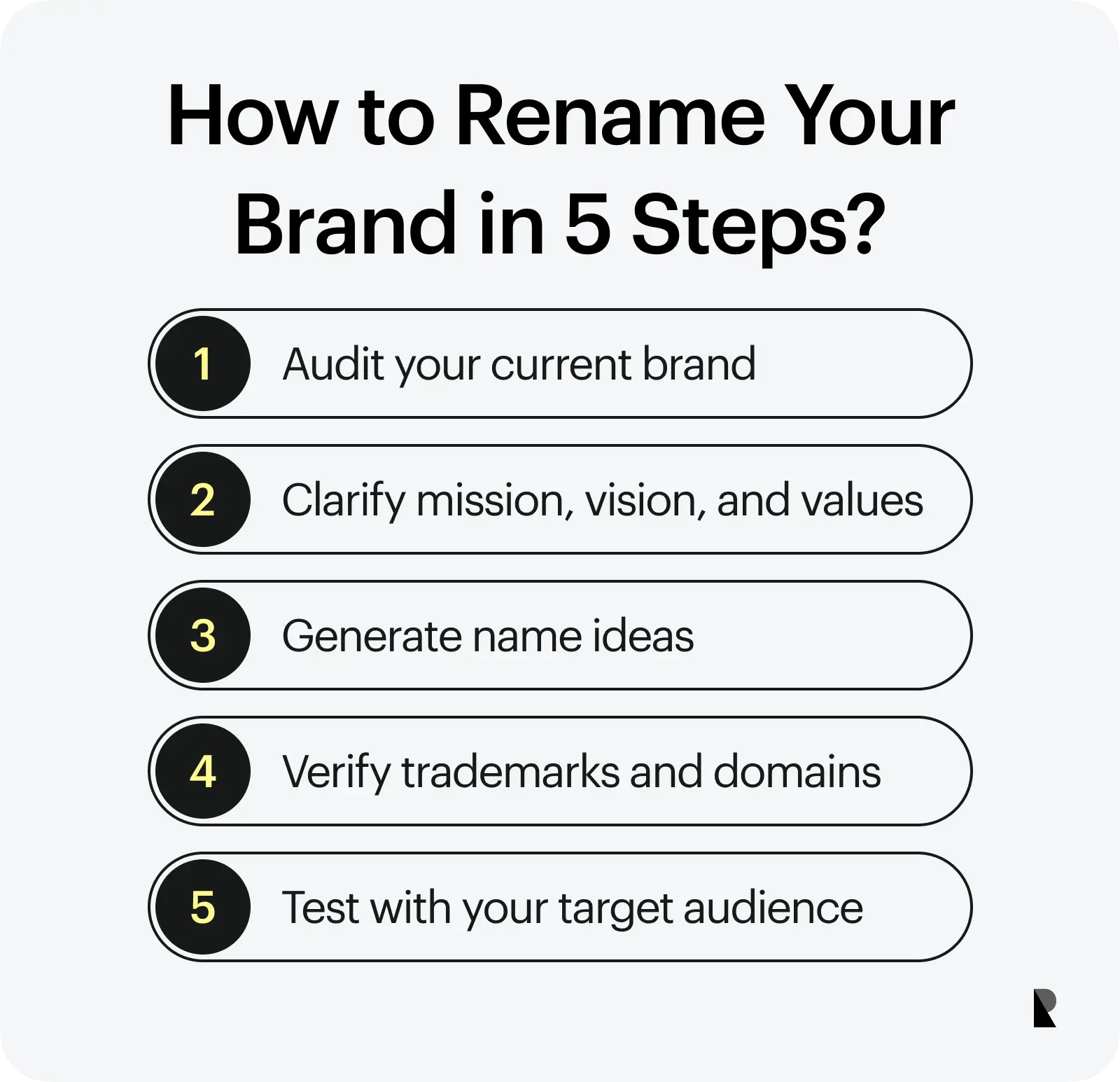
Announcing and launching the new brand name and identity
Before publicly announcing your new brand name and identity, many things happen behind the scenes to ensure a smooth transition.
Inform and orient your team
It is crucial to create a comprehensive communication and rebranding plan detailing the company's brand strategy for launching its new brand name. It must have a timeline, key messages your brand wants to convey, the reason for the name change, and communication channels.
More importantly, hold a meeting or send emails written by the CEO to ensure your stakeholders are well-informed before the final rollout.
Create a new brand guideline
Brand changes can alter processes that may confuse your internal team. You should set up internal resources like brand guidelines that your employees can access through an internal website or portal. These should include FAQs, directions on how to use the new name, and other marketing materials resources.
Another crucial step is to offer a brand training workshop so your internal team can familiarize themselves with the new brand name and messaging.
Announce to your customers and the public
There are no set rules for how to go about this, as every brand audience differs. But it's always good to start with a press release outlining the changes made to the brand and their significance.
Planning a launch campaign to generate buzz and create awareness through social media posts, email blasts, and events is also ideal. Finally, follow up after the launch by conducting surveys or holding Q&A sessions to learn how customers respond to the rebranding process.
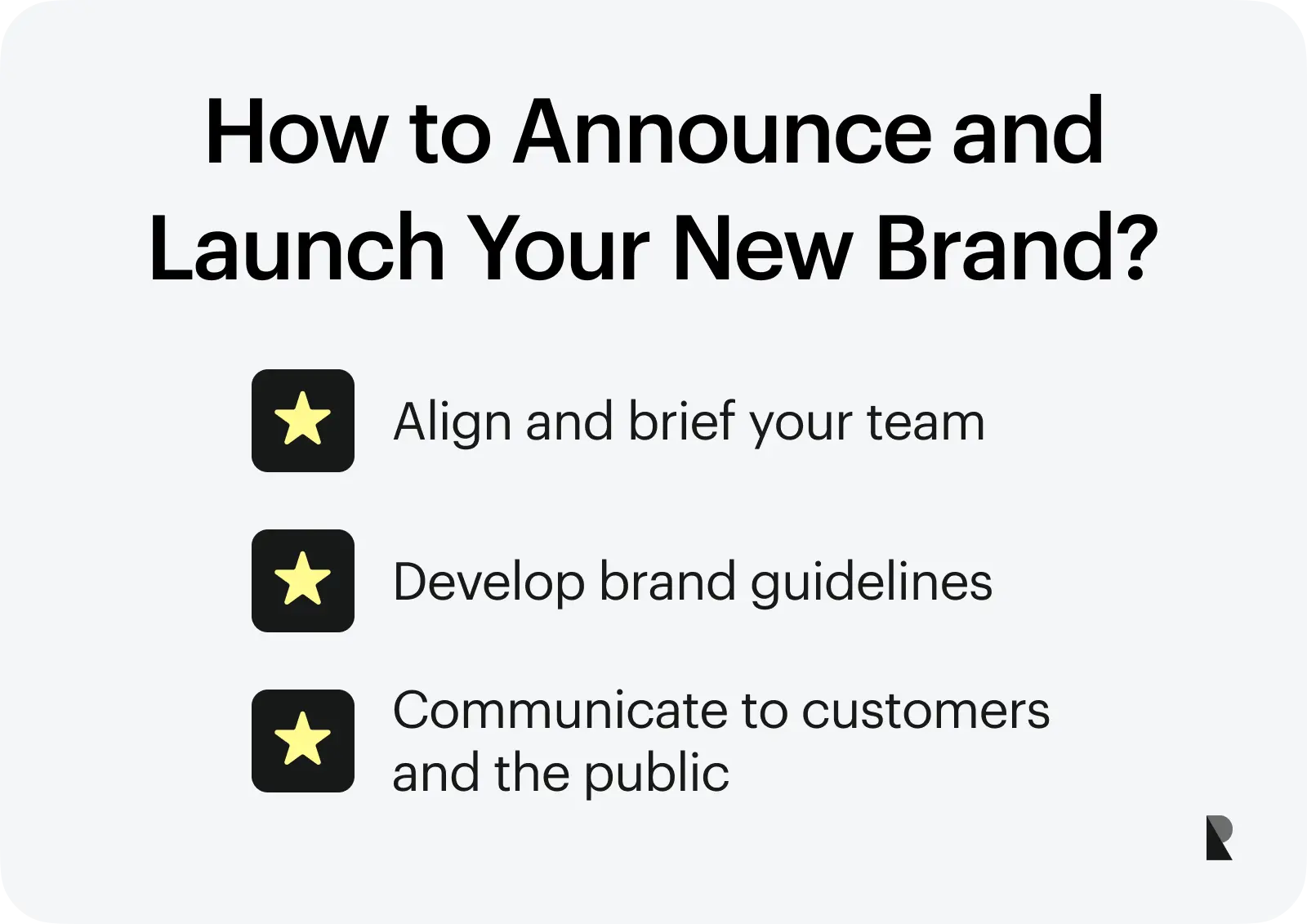
Create a seamless rebrand
Rebranding and implementing a name change requires the right people and strategy to protect your brand equity at the right time. They don't happen on a whim and are crucial in rebirthing your brand.
Let go of your name change and other branding woes and have a branding agency like Ramotion ease your worries. Work with a team of experts to achieve your goals!
Jan 14, 2025
